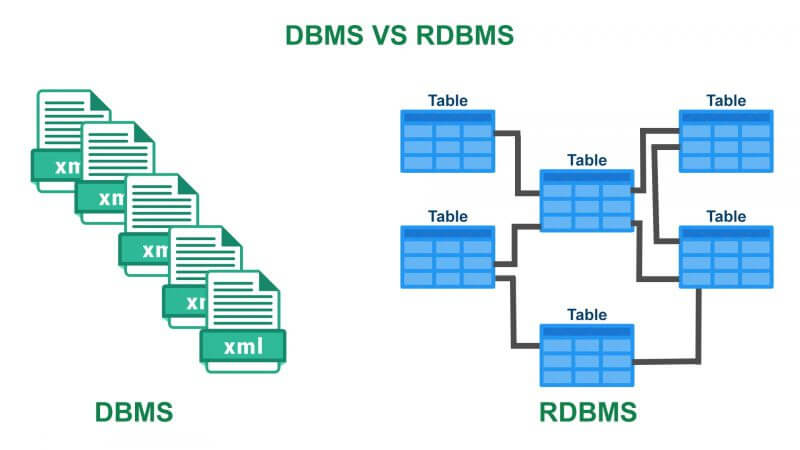What is the Difference Between DBMS and RDBMS?
DBMSs and RDBMSs are so similar in function and operation that we’ve given them the same names.
Some DBMSs and RDBMSs, especially proprietary products, do use the same types of terms to describe them. However, there are some essential distinctions between the two that we’ll go over in this article.
What is a Database?
A database management system (DBMS) is a collection of programs that enables you to store, modify, and retrieve data from a database. A DBMS consists of three components:
The data: This is the data to be stored in the database.
The database schema: This is the database structure that defines the relationships between the data.
The database engine: This program stores, retrieves and updates the data in the database.
When you store data in a database, you first need to define the structure of the database. This is done using the database schema. The schema defines the relationships between the data, and the database engine uses this information to store, retrieve, and update the data.
The database engine is the heart of the DBMS. It is responsible for storing, retrieving, and updating the data in the database. The database engine uses the database schema to understand the relationships between the data.
What is DBMS?
A database management system (DBMS) is software that enables storing, retrieving, updating, and deleting data from the database. It provides security and integrity to the database. It is software that is used to manage the database.
What is RDBMS?
An RDBMS is a software system that stores data in the form of tables. Tables are columns and rows, and each table is typically related to other tables in the database. RDBMSs are the most popular type of DBMS, and they are used in a wide variety of applications.
The RDBMS was first developed in the 1960s and 1970s by IBM. It’s a type of DBMS that stores and retrieves data from a database in the form of tables. It organises this data in rows and columns. By organising this data, relational DBMSs use a set of rules to match and find the data when needed. They store all of the data for a given data set in tables. You can create one or more rows in a table with the same fields. If your rows have the same data in the same fields, it’s considered a table.
You can also add a new row to a table. The new row can have different or the same data as the other rows in the table. When you add a new row, it overwrites any existing data. To query this data, a query is performed to retrieve and display the information in a format the end user can use.
Relational database management systems (RDBMS) are the most popular type of database engine. RDBMS use the relational model to store data. In the relational model, data is stored in tables. Tables are similar to folders in a file system. Each table has a name and a set of columns. Columns are similar to files in a file system. Each column has a name and a data type.
Data is stored in rows in a table. Rows are similar to files in a file system. Each row has a unique ID, and each column in a row contains a piece of data. The data in a column can be of any data type. The relational model enables you to define relationships between the data in different tables. For example, you can define a relationship between the data in the table of students and the data in the table of courses. In this relationship, the student table is the parent table, and the courses table is the child table.
The relational model enables you to store data in a normalised form. Normalisation is organising the data in a database so it can be easily retrieved and updated.
How do DBMS and RDBMS Differ from Each Other?
There are several differences between DBMS and RDBMS. The most crucial difference is that RDBMSs are designed to work with data organised in tables, while DBMSs are not. RDBMSs also support SQL (Structured Query Language), a standard language for accessing and manipulating data in a database. Not all DBMSs do not support SQL.
Another difference between DBMS and RDBMS is that RDBMSs are usually more complex and feature-rich than DBMSs. This is because RDBMSs are designed to support the complex data relationships often found in business applications. RDBMSs also often include tools for managing users and permissions and backing up and restoring data.
Let’s understand DBMSs and RDBMS in detail:
There are many different types of database management systems (DBMS), but the two most common are relational database management systems (RDBMS) and non-relational database management systems (DBMS). Both have their own advantages and disadvantages, and each is better suited for different types of applications. Here are five of the key differences between RDBMS and DBMS:
1. Data Model
The most fundamental difference between RDBMS and DBMS is the data model they use to store data. RDBMS uses the relational model, which organises data into tables with rows and columns. This model is easy to understand and use, and facilitates efficient data retrieval. DBMS, on the other hand, uses the navigational model, which stores data as a series of records connected by links. This model is more complex and less efficient for data retrieval, but it is more flexible in terms of data modelling.
2. Data Manipulation
Another important difference between RDBMS and DBMS is how data is manipulated. RDBMS uses structured query language (SQL), which is a standard language for accessing and manipulating data in a relational database. SQL is easy to learn and use and provides a high level of control over data manipulation. On the other hand, DBMS uses a proprietary data manipulation language specific to the particular DBMS. This language is usually more difficult to learn and use, but it can be more powerful and flexible than SQL.
3. Data Integrity
RDBMS and DBMS also differ in terms of data integrity. RDBMS enforces data integrity by using data type checking and constraint enforcement. This means that data is checked for correctness and consistency when entered into the database, and constraints are used to ensure that data remains consistent when updated. DBMS does not enforce data integrity to the same extent as RDBMS but provides some data integrity features, such as referential integrity.
4. Transaction Processing
RDBMS and DBMS also differ in terms of transaction processing. RDBMS supports features such as Atomicity, Consistency, Isolation, and Durability (ACID), which ensures that data is handled correctly in the event of a failure. DBMS does not support all of these features but provides some level of transaction processing.
5. Scalability
Finally, RDBMS and DBMS differ in terms of scalability. RDBMS is more scalable than DBMS because it is easier to add new servers to an RDBMS environment and configure them to work together. DBMS is less scalable than RDBMS because it is more difficult to add new servers to a DBMS environment and configure them to work together.

Advantages of using DBMS
There are many advantages of using a DBMS rather than an RDBMS. First, a DBMS can provide a higher level of abstraction than an RDBMS. This means that the user does not need to be concerned with the details of how the data is stored or retrieved. Second, a DBMS can provide a more efficient way to store and retrieve data. An RDBMS typically stores data in a tabular format, which can be inefficient when retrieving data that is not stored in a tabular format.
Third, a DBMS can provide a more flexible way to store and retrieve data. For example, a DBMS can store data in a hierarchical format, which can be more efficient when retrieving data stored in a hierarchy. Fourth, a DBMS can provide a more powerful way to query data. An RDBMS typically supports only simple queries, while a DBMS can support more complex queries.
Fifth, a DBMS can provide a more user-friendly interface than an RDBMS. This means that the user does not need to be familiar with the details of the database in order to use it. Sixth, a DBMS can provide a more secure way to store and retrieve data. An RDBMS typically stores data in a flat file, which can be more vulnerable to security attacks.
Advantages of using RDBMS
RDBMS is the basis for SQL, and for all modern database systems such as MS SQL Server, IBM DB2, Oracle, MySQL, and Microsoft Access. RDBMS is a powerful tool for managing data. It is a user-friendly system that allows users to create, update, and delete data easily.
RDBMS is a powerful tool for managing data because it is easy to use. RDBMS is a user-friendly system that allows users to easily create, update, and delete data. RDBMS is also very flexible. It allows users to easily change the structure of their data and the data itself. RDBMS is also a very reliable system. It is designed to keep data safe and secure and always available when needed.
There are many advantages to using RDBMS. RDBMS is faster than DBMS. RDBMS is also a very flexible system. It allows users to easily change the structure of their data and the data itself. RDBMS is also a very reliable system. It is designed to keep data safe and secure and ensure it is always available when needed.
Also Read: 5 Most Popular Free Database Designing Tools
Which one is better, RDBMS or DBMS?
ORDBMS (Object Relational Database Management System) is a more advanced version of OODBMS that incorporates OODBMS ( Object-Oriented Database Management System). OODBMS is a database management system that uses OO programming language concepts for data administration. While it increases speed and flexibility and lowers development costs when compared to RDBMS, it has several drawbacks, including increased expenses for computer resources, the possibility of design mistakes, and data inconsistency. RDBMSs address these problems.
ORDBMS is a database management system (DBMS) built on relational and object-oriented database models. As a result, an ORDBMS may be considered an RDBMS as well. In other words, ORDBMS is utilised both as a relational database management system and as an ORDBMS. Hence, RDBMS is better in terms of large data.
It supports objects, classes, and inheritance and offers a more intuitive interface to various object-oriented programming languages. Additionally, it enables data model expansions by adding new data types and functions. Microsoft, Oracle, and Sybase have all produced object-relational versions of their respective products. It is better suited for applications that handle many short-lived transactions on complex-structured data objects.
Conclusion
There are two main types of database management systems: relational database management systems (RDBMS) and non-relational database management systems (DBMS). Both systems have their own advantages and disadvantages, but which one is better for your needs depends on the specific requirements of your project.
RDBMS are well-suited for applications requiring high data consistency levels, such as financial or medical systems. This is because RDBMS use a rigid structure that helps to ensure that data is entered correctly and consistently. This structure also makes it easy to query data and generate reports.
DBMS is more flexible than RDBMS and is, therefore, better suited for applications that require a high degree of flexibility. For example, a DBMS would be a good choice for a system that needs to store data that doesn’t fit into a predefined structure. Both RDBMS and DBMS have their place in the world of database management, and which one you choose will depend on the specific needs of your project.



